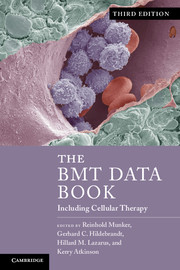Book contents
- Frontmatter
- Contents
- List of contributors
- Foreword
- Preface
- Acknowledgments
- Section 1 Basic science
- 1 Hematopoietic cell transplantation: past, present, and future
- 2 Basic science
- Section 2 Hematologic malignancies
- Section 3 Solid tumors
- Section 4 Nonmalignant disorders
- Section 5 Cellular therapy
- Section 6 Practical aspects and procedures
- Section 7 Complications
- Section 8 The BMT/SCT pharmacopoeia
- Section 9 HLA-testing and laboratory medicine
- Appendix Guide to the internet and literature databases relevant for BMT/SCT
- Index
- References
2 - Basic science
Published online by Cambridge University Press: 05 August 2013
- Frontmatter
- Contents
- List of contributors
- Foreword
- Preface
- Acknowledgments
- Section 1 Basic science
- 1 Hematopoietic cell transplantation: past, present, and future
- 2 Basic science
- Section 2 Hematologic malignancies
- Section 3 Solid tumors
- Section 4 Nonmalignant disorders
- Section 5 Cellular therapy
- Section 6 Practical aspects and procedures
- Section 7 Complications
- Section 8 The BMT/SCT pharmacopoeia
- Section 9 HLA-testing and laboratory medicine
- Appendix Guide to the internet and literature databases relevant for BMT/SCT
- Index
- References
Summary
The human hemopoietic system
Understanding of the human hemopoietic and immune systems has advanced markedly during the past 30 years. The key components of the human hemopoietic system are the hemopoietic growth factors, the hemopoietic stem cell, and the marrow microenvironment. Transcription factors direct hematopoietic differentiation. Each of these components is detailed further in the following sections.
Hemopoietic growth factors
Colony-stimulating factors (CSFs)Granulocyte colony-stimulating factor (G-CSF)Granulocyte–macrophage colony-stimulating factor (GM-CSF)Macrophage colony-stimulating factor (M-CSF)Interleukin (IL)-3ErythropoietinThrombopoietinIL-5
Stem cell factorsKit ligand (stem cell factor)Flt ligand
Synergistic factorsIL-1IL-6IL-7IL-9IL-10IL-11IL-12Leukemia inhibitory factor (LIF)
Inhibitors/bidirectional regulatorsTumor necrosis factor-alpha (TNF-α)Transforming growth factor-beta (TGF-β)Macrophage inflammatory protein-1β (MIP-1β)Interferon gamma (IFN-γ)
- Type
- Chapter
- Information
- The BMT Data BookIncluding Cellular Therapy, pp. 7 - 24Publisher: Cambridge University PressPrint publication year: 2013



